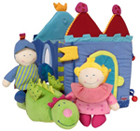Choosing Baby Toys
 Today, Carole Arsenault of Newborn Nurses offers tips for choosing baby toys:
Today, Carole Arsenault of Newborn Nurses offers tips for choosing baby toys:
Babies learn by using their five senses: sight, touch, smell, hearing, and taste. It’s not always necessary to purchase expensive toys for your baby; some of the very best toys are everyday objects we have in our homes (e.g., measuring cups or spoons, empty plastic containers). However, when you are ready to purchase a toy for your baby here are some basic guidelines to consider.
Choosing Chemically Safe Toys
The amount of information about toxins and chemicals in our environment is overwhelming and can be confusing to many. I recommend being careful about what you give baby to play with, particularly because babies tend to put everything in their mouth. Here are some basic guidelines to follow when picking out your baby’s playthings.
Check wooden toys. Not all woods are equal. Buy only solid wood that has not been treated with formaldehyde. Make sure the paint or stain on the wood is non-toxic.
Check soft materials Stuffed animals or activity gyms should not contain the flame retardants found in polyurethane foam and filling materials.
For more information about chemicals and product safety, the Environmental Working Group is a great resource that provides consumers with unbiased safety information. They have a special section dedicated to information for parents. I also recommend Haba toys (see Oompa for an excellent collection) and in general European toys are a good place to start; their safety standards are set much higher than in the US.
Image credit: Haba Dragonstone Castle, from Oompa.
